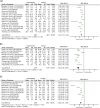Physical Activity Following Hip Arthroscopy in Young and Middle-Aged Adults: A Systematic Review
- PMID: 31993831
- PMCID: PMC6987281
- DOI: 10.1186/s40798-020-0234-8
Physical Activity Following Hip Arthroscopy in Young and Middle-Aged Adults: A Systematic Review
Abstract
Background: Hip arthroscopy is a common surgical intervention for young and middle-aged adults with hip-related pain and dysfunction, who have high expectations for returning to physical activity following surgery. The purpose of this review was to evaluate the impact of hip arthroscopy on physical activity post-arthroscopy.
Methods: A systematic search of electronic databases was undertaken in identifying studies from January 1st 1990 to December 5th 2019. The search included English language articles reporting physical activity as an outcome following hip arthroscopy in adults aged 18-50 years. Quality assessment, data extraction and synthesis of included studies were undertaken.
Results: Full text articles (n = 234) were assessed for eligibility following screening of titles and abstracts (n = 2086), yielding 120 studies for inclusion. The majority (86%) of the studies were level 4 evidence. No studies reported objective activity data. The most frequently occurring patient-reported outcome measure was the Hip Outcome Score-sport-specific subscale (HOS-SS, 84% of studies). Post--arthroscopy improvement was indicated by large effect sizes for patient-reported outcome measures (standard paired difference [95% confidence interval] -1.35[-1.61 to -1.09] at more than 2 years post-arthroscopy); however, the majority of outcome scores for the HOS-SS did not meet the defined level for a patient-acceptable symptom state.
Conclusion: The current level of available information regarding physical activity for post arthroscopy patients is limited in scope. Outcomes have focused on patients' perceived difficulties with sport-related activities with a paucity of information on the type, quality and quantity of activity undertaken.
Level of evidence: Level IV, systematic review of Level 2 through to Level 4 studies.
Keywords: Activity; Hip-arthroscopy; Outcomes; Rehabilitation; Sport.
Conflict of interest statement
Denise Jones, Kay Crossley, Ilana Ackerman, Harvi Hart, Karen Dundules, Michael O'Brien, Benjamin Mentiplay, Joshua Heerey and Joanne Kemp declare that they have no conflicts of interest relevant to the content of this review.
Figures



References
Publication types
LinkOut - more resources
Full Text Sources
Research Materials

